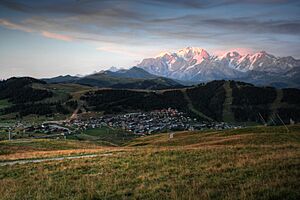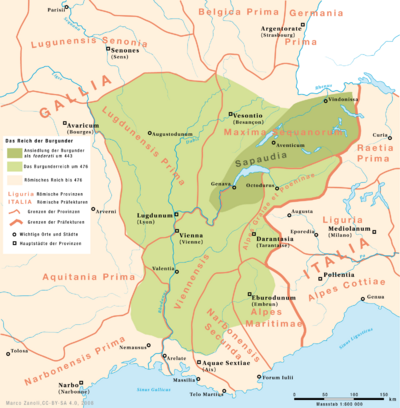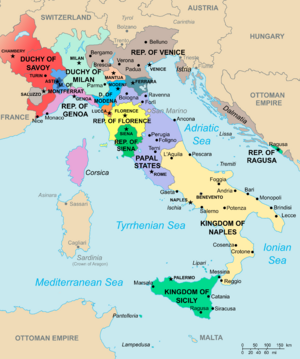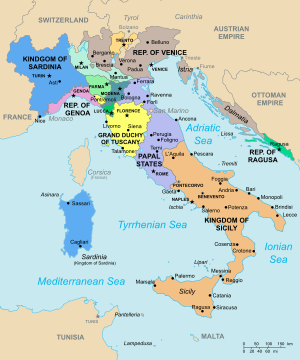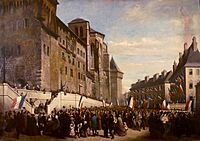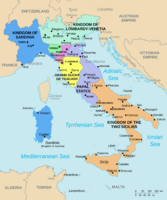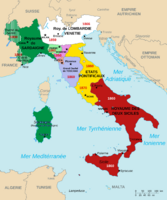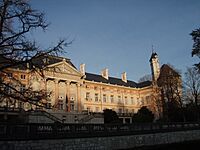Savoy facts for kids
Quick facts for kids
Savoy
|
|
|---|---|
|
Anthem: Le Chant des Allobroges
The Song of the Allobroges |
|
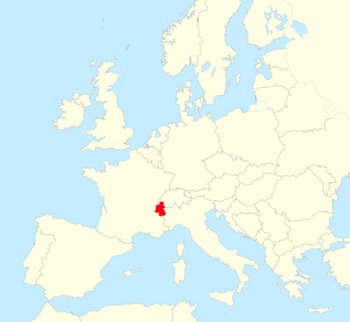 |
|
| Capital | Chambéry |
| Largest city | Annecy |
| Common languages |
|
| Demonym(s) |
|
| Legislature | Sovereign Senate of Savoy (dissolved in 1860) |
| Establishment | |
|
• Foundation of County
|
1003 |
|
• Promotion to Duchy by Emperor Sigismund
|
February 19, 1416 |
|
• Annexation by France
|
June 14, 1860 |
| Area | |
|
• Total
|
10,416 km2 (4,022 sq mi) |
| Population | |
|
• 2020 census
|
1,274,956 |
| Time zone | UTC+1 (CET) |
|
• Summer (DST)
|
UTC+2 (CEST) |
| Driving side | right |
| Calling code | 33 |
Savoy (pronounced "suh-VOY") is a historic area in the Western Alps mountains. It sits between different cultures, near Occitania and Piedmont. This region stretches from Lake Geneva in the north to the Dauphiné in the south and west, and to the Aosta Valley in the east.
Savoy started as a feudal (meaning a system where land is exchanged for loyalty and service) County of Savoy around the 11th century. It was ruled by the House of Savoy, a powerful family. The original area, sometimes called "ducal Savoy," is mostly where the French departments of Savoie and Haute-Savoie are today. Over time, the Duchy of Savoy (from 1416 to 1860) grew to include parts of what is now western Italy and southwestern Switzerland.
The current border between France and Italy was set in 1858 by the Plombières Agreement. This agreement was made to help unify Italy. It gave western Savoy to France. The House of Savoy kept its lands in Piedmont and Liguria (now in Italy). This family later became the ruling family of Italy.
Geography of Savoy
Today, Savoy is part of the Auvergne-Rhône-Alpes region in France. After it became part of France in 1860, Savoy was split into two administrative areas called departments: Savoie and Haute-Savoie.
The traditional capital city of Savoy is Chambéry. It is located on the Leysse and Albane rivers. Chambéry is home to the old castle of the House of Savoy and the Savoyard senate (a type of government council). The old state of Savoy included six main areas:
- Savoie Propre (also known as Ducal Savoy), with its capital at Chambéry.
- Chablais, with its capital at Thonon-les-Bains.
- Faucigny, with its capital at Bonneville.
- Tarentaise, with its capital at Moûtiers.
- Maurienne, with its capital at Saint-Jean-de-Maurienne.
- Genevois, with its capital at Annecy.
The County and later Duchy of Savoy also included Turin and other lands in Piedmont. Piedmont is a region in northwestern Italy that borders Savoy. These lands were also owned by the House of Savoy. The capital of the Duchy stayed in Chambéry until 1563. Then, it moved to Turin, which was safer from French attacks.
History of Savoy
Early Times in Savoy
The area of Savoy was first home to the Allobroges, a Gallic people. The Roman Republic took control of them in 121 BC. The name Savoy comes from the old Latin word Sapaudia. This word meant a forest of fir trees or an upland forest. It was first written down in 354 AD.
In 443 AD, a group called the Burgundians settled in Sapaudia. This happened after they were defeated by a Roman general named Flavius Aetius.
Middle Ages and the Rise of Savoy
By the 8th century, the area that would become Savoy was part of Francia. When Francia was divided in 843 by the Treaty of Verdun, Savoy became part of a kingdom called Middle Francia. After this kingdom broke up, Savoy became part of the Kingdom of Burgundy-Arles.
From the 10th to the 14th century, the House of Savoy family slowly gained power. Their territory, known as the County of Savoy, grew between 1003 and 1416. In 1361, the County of Savoy officially separated from the Kingdom of Arles. It gained the County of Nice in 1388 and the County of Geneva in 1401. The city of Geneva itself was ruled by its prince-bishop.
The Duchy of Savoy
On February 19, 1416, Sigismund, Holy Roman Emperor, made the County of Savoy an independent duchy. Amadeus VIII became its first duke. Savoy was located in the Alps, between the influence of France and northern Italy. During the Renaissance, Savoy was not very developed. It had few small towns and mostly relied on farming.
Savoy's location was also important for military reasons. During the many wars between France and Spain over control of northern Italy, Savoy was key. It gave France a way into Italy and served as a buffer (a protective zone) between France and Spanish lands in Italy. In 1563, Emmanuel Philibert moved the capital from Chambéry to Turin. Turin was a safer location from French attacks.
In 1714, after the War of the Spanish Succession, Savoy became part of the Kingdom of Sicily. Later, in 1720, it became part of the Kingdom of Sardinia. Even though the rulers were called Kings of Sardinia, Turin remained their capital city.
French Revolutionary Wars and Changes
French revolutionary forces took control of Savoy between 1792 and 1815. The whole region first became a French department called Mont-Blanc. In 1798, it was split into two departments: Mont-Blanc and Léman. Savoy officially left the Holy Roman Empire in 1801. In 1793, the forces of Savoy, Piedmont, and Aosta Valley fought against the French at the Battle of Méribel but lost.
After Napoleon's defeat, two-thirds of Savoy were given back to the Kingdom of Sardinia in 1814. About one-third, including Chambéry and Annecy, stayed with France. After Napoleon's brief return, the rest of Savoy was given back to the Kingdom of Sardinia at the Congress of Vienna. This was done to make Sardinia stronger as a buffer state against France.
Modern History and Joining France
How Savoy Joined France
In 1848, the French Second Republic tried to take over Savoy. A group of 1,500 men from Lyon invaded Savoy and took Chambéry. They said Savoy was now part of France. However, local people fought back and chased them away.
On July 21, 1858, a secret meeting happened between the prime minister of Sardinia, Camillo Benso, Count of Cavour, and the French emperor Napoleon III. Cavour promised to give the County of Nice and the Duchy of Savoy to France. This was in exchange for French military help against the Austrian Empire during the Italian unification. Even though it was a secret, the news spread quickly.
The treaty that officially made Nice and Savoy part of France was signed in Turin on March 24, 1860. This was called the Treaty of Turin. Some people in northern Savoy wanted to join Switzerland because they had strong economic ties there. To make joining France more appealing, the French government created a Free-Trade Zone. This allowed northern Savoyard towns to continue trading with Geneva without taxes.
After the treaty was signed, a public vote (called a plebiscite) was held on April 22-23. Men could vote "Yes" to join France or "No" to reject the treaty. They were not given options to join Switzerland, stay with Italy, or become independent. The vote showed 99.8% in favor of joining France. However, some people, especially the British government, claimed there was vote-rigging. A reporter from The Times called the vote "the lowest and most immoral farce." He said there was no real control over the voting and that opposition was stopped by threats.
The annexation officially happened on June 14, 1860. Later, two more agreements were signed between France and Sardinia to sort out any remaining issues. This whole process was part of the secret Plombières Agreement. It allowed the final steps for Italy to become a unified country. The House of Savoy family kept their Italian lands and became the ruling family of Italy.
-
People of Chambéry with French flags celebrating the annexation in 1860.
-
French annexation in 1860 (black) after the signing of the Treaty of Turin and a regional referendum in favor of the attachment to France (French)
Savoy in the 20th Century
In 1919, France ended the military neutrality of parts of Savoy. This went against the original annexation treaty and the agreements made at the Congress of Vienna. France also removed the free trade zone. Both of these rules had been broken unofficially during World War I. In 1932, an international court criticized France for not following the Treaty of Turin's rules for Savoy and Nice.
By 1960, the word "annexation" had a negative meaning in France. So, the event was renamed Rattachement de la Savoie à la France, which means "Incorporation of Savoy to France." French officials used this new term during the 100th anniversary celebrations. A member of the French Academy explained that "incorporation" was better. He said Savoy was not taken by force but joined freely by the will of its people.
A former French politician, P. Taponnier, also spoke about the "incorporation." He said it was a "pact of love and fidelity" and that Savoy joined France by its own free choice. He added that Savoyards did not feel Italian and spoke French, which is why they asked to be incorporated into France.
Politics in Savoy
Modern Regionalist Movements
Since the mid-20th century, groups wanting more local control have appeared in Savoy. This is similar to other historic regions in France. The Mouvement Région Savoie (Savoy Regional Movement) started in 1971. It wants more self-rule for the region. Unlike some other French regions, Savoy does not have its own separate region within France. It is part of the Auvergne-Rhône-Alpes region.
A group called La Région Savoie, j’y crois ! (I believe in the Savoy Region!) was founded in 1998. This group wants the two departments of Savoie and Haute-Savoie to be replaced by a regional government. They want this government to be separate from Auvergne-Rhône-Alpes and have more powers.
A small separatist movement has also appeared in Savoy. The most well-known group is the Ligue Savoisienne, started in 1994. In 1998, their leader, Patrice Abeille, won one seat in regional elections. In 2004, "Waiting for Freedom in Savoy" was created to promote peaceful separation to young people.
Surveys from 2000 showed that between 41% and 55% of people wanted a separate Savoy region. About 19% to 23% wanted to separate from France completely. In 2005, Hervé Gaymard suggested that Savoie should have a special status, like a French region.
Debates About History
In recent years, there has been much discussion about whether the 1860 annexation was truly fair. The Ligue Savoisienne, for example, says the Treaty of Turin and the vote were not valid. They argue that the vote was not free or fair.
Today, historians generally agree that the 1860 vote had some problems. However, they also say that the main way Savoy joined France was through the Treaty of Turin. The vote was mostly to show that people in Savoy supported joining France after the treaty was signed. A historian from the University of Savoy, Sylvain Milbach, said the vote was like those under Napoleon. But he also believes that even a completely fair vote would not have changed the outcome much. He thinks most Savoyards wanted to become French. This is also the official view of the General Council of Savoie today.
See also
- House of Savoy
- Italian Savoyards
- List of active separatist movements in Europe#France § Notes
- Savoy States
- Maurice-Mollard Plaza




